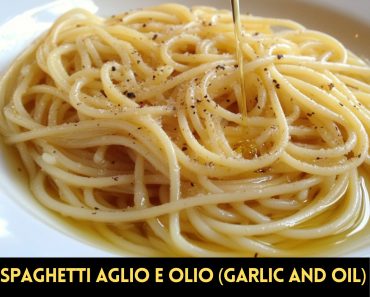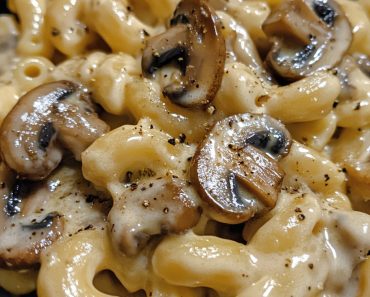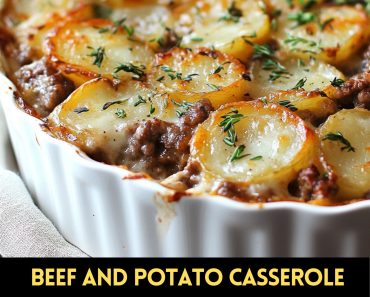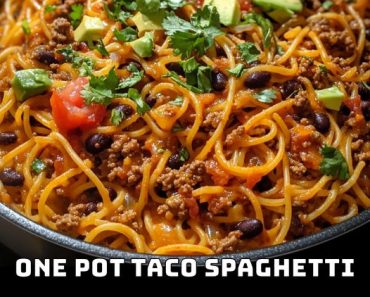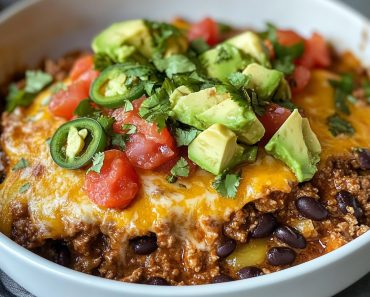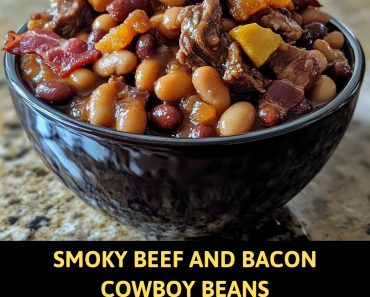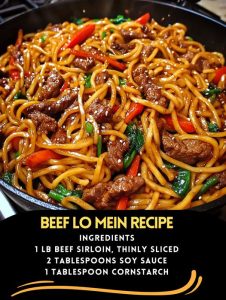
Beef Lo Mein Recipe 🍜
Take a moment to savor the comforting flavors of this Beef Lo Mein—a dish that effortlessly brings together the rich, umami taste of stir-fried beef with crisp, colorful vegetables and perfectly coated noodles. This is a perfect go-to recipe when you want something that feels indulgent yet balanced. Whether it’s for a quick weeknight dinner or a cozy weekend meal, this dish brings restaurant-quality goodness to your home with ease.
Ingredients Overview
- Beef Sirloin (1 lb, thinly sliced): Tender and flavorful, beef sirloin is ideal for quick stir-frying. Thin slices ensure fast cooking and maximum flavor absorption.
- Soy Sauce (2 tablespoons): This staple ingredient adds a salty, savory punch to both the marinade and the final sauce, enhancing the beef’s natural flavors.
- Cornstarch (1 tablespoon for beef, 1 tablespoon for slurry): Cornstarch helps tenderize the beef and also thickens the sauce at the end, making it luxuriously silky.
- Vegetable Oil (2 tablespoons): Neutral in flavor, vegetable oil is perfect for stir-frying at high heat.
- Lo Mein Noodles (8 oz): Traditional lo mein noodles are soft yet chewy and are designed to soak up all the delicious sauce. Spaghetti can be used as a substitute if lo mein noodles are unavailable.
- Onion (1, thinly sliced): Sweet and aromatic, onions add depth to the dish, balancing the saltiness of the soy sauce and oyster sauce.
- Garlic (2 cloves, minced): A must-have in Asian-inspired dishes, garlic infuses the oil with its robust flavor, creating a fragrant base for the stir-fry.
- Carrots (1 cup, sliced): Vibrant and slightly sweet, carrots add color and a crunchy texture.
- Bell Peppers (1 cup, sliced): You can use a mix of red, green, or yellow bell peppers to add a pop of color and fresh, crisp bite.
- Broccoli Florets (1 cup): Broccoli brings a mild sweetness and absorbs the flavors of the sauce, becoming beautifully tender.
- Snow Peas (1 cup): Crisp and fresh, snow peas add texture and a slight sweetness to the stir-fry.
- Oyster Sauce (2 tablespoons): Rich and slightly briny, oyster sauce adds depth and umami that enhances the overall flavor profile of the dish.
- Sesame Oil (1 teaspoon): Just a little sesame oil gives the dish a nutty aroma, taking the flavor complexity to the next level.
- Beef Broth (¼ cup): Adds a meaty richness that blends well with the soy and oyster sauces, giving the dish body and moisture.
- Green Onions and Sesame Seeds (optional for garnish): These finishing touches add a fresh, zesty kick and a little crunch.
Step-by-Step Cooking Instructions
1. Marinate the Beef
Toss the Beef with Flavor: In a medium bowl, combine the thinly sliced beef with 2 tablespoons soy sauce and 1 tablespoon cornstarch. Stir until the beef is evenly coated, then set aside for 10-15 minutes. This marinade will infuse the beef with flavor while the cornstarch helps tenderize it, resulting in melt-in-your-mouth bites.
2. Cook the Noodles
Boil the Lo Mein Noodles: While the beef is marinating, cook the 8 oz of lo mein noodles (or spaghetti) according to the package instructions. Once cooked to al dente, drain and set aside.
Helpful Tip: Toss the cooked noodles with a drizzle of sesame oil to prevent them from sticking together and to enhance their flavor.
3. Stir-Fry the Beef
Brown the Beef: Heat 1 tablespoon of vegetable oil in a large skillet or wok over medium-high heat. Once hot, add the marinated beef slices and stir-fry for 4-5 minutes until the beef is browned and cooked through. Remove the beef from the skillet and set it aside.
4. Stir-Fry the Vegetables
Sauté the Vegetables: In the same skillet, add the remaining 1 tablespoon of vegetable oil. Toss in the onion, garlic, carrots, bell peppers, broccoli, and snow peas, and stir-fry for 5-7 minutes until the vegetables are tender-crisp but still vibrant and colorful.
Helpful Tip: For evenly cooked vegetables, cut them into similar-sized pieces. Broccoli florets should be small enough to cook through but still retain some bite.
5. Combine the Beef and Vegetables
Bring Everything Together: Add the cooked beef back into the skillet, mixing it with the stir-fried vegetables.
6. Create the Sauce
Whisk the Sauce: In a small bowl, whisk together ¼ cup soy sauce, 2 tablespoons oyster sauce, 1 teaspoon sesame oil, and ¼ cup beef broth. Pour this sauce mixture into the skillet, stirring well to coat the beef and vegetables evenly.
7. Thicken the Sauce
Add the Cornstarch Slurry: In a separate small bowl, mix 1 tablespoon cornstarch with 1 tablespoon water to create a slurry. Pour the slurry into the skillet and stir constantly for 1-2 minutes until the sauce thickens and coats everything beautifully.
8. Toss with Noodles
Toss the Noodles with Sauce: Finally, add the cooked noodles to the skillet, gently tossing everything together until the noodles are fully coated in the savory sauce.
Helpful Tip: Use tongs or chopsticks to gently toss the noodles to avoid breaking them.
9. Garnish and Serve
Serve with Flair: Garnish your Beef Lo Mein with chopped green onions and sesame seeds for added flavor and presentation. Serve hot and enjoy!
Storage and Reheating Tips
- Storage: Leftover Beef Lo Mein can be stored in an airtight container in the refrigerator for up to 3 days.
Helpful Tip: Store the noodles and stir-fry separately if you plan to reheat later. This will help prevent the noodles from becoming soggy. - Reheating: Reheat your Beef Lo Mein on the stove over medium heat, adding a splash of water or beef broth to revive the sauce. Stir occasionally until warmed through. You can also microwave it in 30-second intervals, stirring between each round.
20 Frequently Asked Questions
1. Can I use chicken instead of beef?
Absolutely! Swap the beef with chicken breast or thighs for a delicious variation.
2. Can I make this recipe vegetarian?
Yes, you can omit the beef and use tofu or extra vegetables like mushrooms for a vegetarian version.
3. Can I use other noodles besides lo mein?
Yes, spaghetti or even ramen noodles can be a great substitute if you don’t have lo mein noodles.
4. What if I don’t have oyster sauce?
You can use hoisin sauce or a bit of soy sauce mixed with a teaspoon of sugar for a similar taste.
5. How do I prevent my beef from getting tough?
Make sure to slice the beef thinly against the grain and don’t overcook it during the stir-fry process.
6. Can I add other vegetables?
Yes! Bok choy, baby corn, or mushrooms would make excellent additions.
7. Can I use frozen vegetables?
You can, but thaw them first and make sure to cook off any excess water to prevent soggy stir-fry.
8. How spicy is this dish?
This recipe is not spicy, but you can add chili flakes or Sriracha for a kick.
9. What can I use instead of beef broth?
Chicken or vegetable broth works well, or even water if you’re in a pinch.
10. Can I meal prep this dish?
Yes, it holds up well in the fridge and can be reheated throughout the week.
11. How do I thicken the sauce if I don’t have cornstarch?
You can use arrowroot powder or flour, but the texture might be slightly different.
12. Can I add more sauce if I want it extra saucy?
Absolutely! Double the sauce ingredients if you prefer a saucier dish.
13. Can I freeze Beef Lo Mein?
It’s not recommended as the noodles can become mushy after thawing.
14. Is this dish gluten-free?
No, but you can make it gluten-free by using tamari or gluten-free soy sauce and noodles.
15. Can I cook this in a slow cooker?
This recipe is best suited for stir-frying, but you could try slow cooking the beef with the sauce and adding stir-fried veggies and noodles later.
16. Can I substitute sesame oil?
If you don’t have sesame oil, you can leave it out or use olive oil, but the dish will lack that nutty flavor.
17. Why do I need to marinate the beef?
Marinating the beef with soy sauce and cornstarch helps tenderize it and adds flavor.
18. Can I use pre-cooked noodles?
Yes, but ensure they’re not overcooked. Toss them in at the last minute to avoid mushiness.
19. Can I make this dish ahead of time?
You can prep the vegetables and marinate the beef ahead of time, but cook everything fresh for the best taste.



